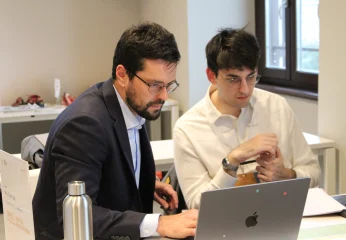Food and media: how has the narrative around the food world has changed

According to the theories of the French anthropologist Claude Levi Strauss, the transition of food from being a central element in the struggle for survival to a cultural element occurred with the cooking of food through fire: the invention that made ‘humans the humans’.
From this point of view, the ethno-anthropological approach is perhaps the one that can most profoundly narrate the food-culture relationship, which is to be understood as a symbolic transition between nature, the raw, and culture, the cooked, but also between nature and society.
Indeed, it is from this moment onwards that food becomes the starting point for extraordinary social, cultural, ethnic, religious and economic developments.
Food as a moment of sociality
The table, in contemporary society, constitutes a meeting place between different sensory channels, transcending the paradigm of need to arrive at that of pleasure, affectivity, sociality and business.
Today, food has become a trend, a fashion: it is not enough to taste it, but it must be told to the 76% of Italians who, in the media, look for food programmes as indicated by Auditel (Q1 2018 period).
To find out more, we met with Salvatore Cosenza professor of the International Master in Food and Beverage Management at Rome Business School who told us:
“I come from a long experience as a TV author. When I worked in this sector we talked about food but not in a way that was, let me say, obsessive as it is today. At every hour of the day there are cooking programmes: on generalist TV, on thematic channels for enthusiasts and even on streaming platforms. Despite the overabundance of media and content, interest in the topic shows no signs of waning.
There are interesting formats in which food, understood as pleasure and experience, is the central theme. Beyond entertainment, however, I would like there to be more focus on nutritional aspects, without lapsing into healthism. It would also be right to emphasise sustainability issues, both environmental and social, to help the public perceive the right value of food. For example, making it clear that if a food is underpaid, it will be the environment or the workers in the agri-food industry who are not paid fairly. There has to be an, if you will pardon the term, ethical approach, even in this field”.
Social Network and Website
With the advent of social networking, the concept of ‘window dressing’ theorised by the sociologist Vanni Codeluppi, in his essays dedicated to the world of communication and consumption phenomena, admirably describes the progressive spectacularisation of everyday life, in which a prominent place is dedicated to food.
Digital media have transformed the communication of the food universe, in its most universal sense.
If since the 1970s it was only journalists specialised in food and wine who dealt with this subject with publications such as the Michelin and Touring Club Guides – let us also remember that the Gambero Rosso Channel, the first themed channel in Italy, was only founded in 1999 and that the first RAI programme dates back to 2000 – today attention is being attracted by foodbloggers, influencers, trendsetters who share experiences, recipes, ideas, photographs and above all opinions through the web.
“With regard to food in the social sphere, inevitably it is sight that is the sense that is most stimulated. When a dish is offered to us unconsciously we analyse it visually. Food design is therefore a powerful tool that can influence us. Then there are the excesses, such as the obsessive pursuit of ‘Instagrammability’ or the infamous ‘food porn’. In my opinion, it is necessary to strike a balance between ‘window dressing’ and substance. A sandwich or a dish may look beautiful and inviting in photos, but if they turn out to be disappointing when tasted, the public will have no qualms about pointing this out on the same social platforms or review sites. Compared to form, taste still remains the key aspect of a customer’s experience, thankfully.
More generally, to make the most of social media, one must consider the language peculiarities of the medium one chooses to communicate in order to plan a correct strategy. In other words, there is no point in conveying content that is perfect in form if you get the medium and target audience wrong. For example: a video lasting several minutes is suitable for YouTube, at most for Facebook. Certainly not on Instagram, where photos, stories and, more recently, reels are to be preferred. The latter actually originated on Tik Tok, a different platform, with an almost frenetic approach, and it is no coincidence that it is the one most used by generation Z.”
Storytelling and Content Management
Storytelling delineates the new dimension of marketing and in this perspective content marketing is the creation of valuable and quality content that allows companies to maintain a competitive advantage in the target market and social, in this, must be experienced as a flywheel for restaurateurs.
“Even for the food world, content marketing is a useful tool. For this, knowing and relying on storytelling techniques is a valid option. During the lectures I like to use the metaphor of the clock: the story is the time marked by the hands, the storytelling techniques are the mechanism of the clock itself. Knowing how stories work allows us to construct and tell them more effectively. Even in ‘Food & Baverage’, it is necessary to employ communication professionals. Unfortunately, very often it is thought that having a social account or being well versed in the web are sufficient elements, especially in a world such as food, which is in fact an everyday topic”.
Skills and competences
“If you want to work in the food communication sector, the main enemy, I repeat, is improvisation. In my opinion, it is necessary to possess the right mix of knowledge: it is not enough to be a marketing expert, you must inevitably also have skills in the strictly gastronomic sphere, as well as knowledge of this world and its dynamics. The human factor must also not be overlooked, i.e. the ability to weave relationships from which interesting personal collaborations or comarketing actions can arise.
At present, unfortunately, the most pressing issue in the catering sector is the shortage of restaurant and kitchen staff. This leads one to see communication as an issue to be thought about at a later date. A question of priorities, of course, but we must not fall into the error of remembering to communicate only when we have a lot of budget available, or even worse, when business is bad.”
SALVATORE COSENZA
Born in Potenza, he has lived and worked in Rome since 2004. For years, he has been a television author of programmes based on ‘user generated content’. He started writing about food and restaurants in 2011. He served as Community City Manager for Yelp in the capital. A contributor for restaurant guides, he writes regularly for Agrodolce.it and collaborates occasionally with other food publications. He collects his articles on his personal website LievitiDigitali.com. Lecturer in craft beer tasting, he is one of the organisers of Italy Beer Week. Marketing and communication consultant for companies in the food & beverage sector.




